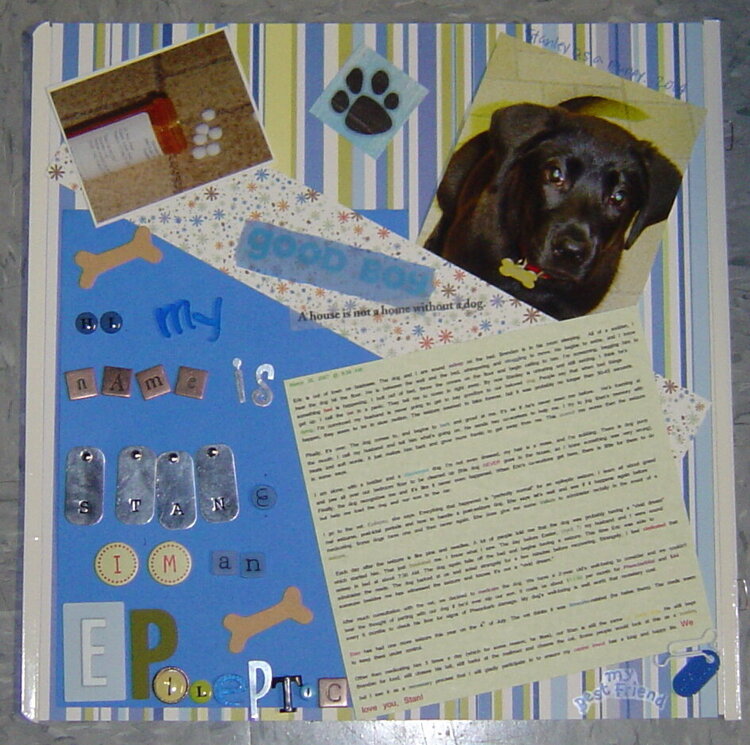
Plus, a FREE Gift! | Details Here.

 Give a Cheer
Give a Cheer
After our dog was diagnosed with epilepsy, I felt the need to make this page. Journaling reads: March 26, 2007 @ 8:38 AM
DH is out of town on business. The dog and I are sound asleep on the bed. DS is in his room sleeping. All of a sudden, I hear the dog hit the floor. He is between the wall and the bed, whimpering and struggling to move. He begins to seize, and I know something bad is happening. I bolt out of bed, throw the covers on the floor and begin calling to him. Iím screaming, begging him to get up. I call the vet in a panic. They tell me to come in right away. By now Stanley is urinating and still seizing. I think heís dying. Iím convinced my husband is never going to get to say goodbye to our beloved dog. People say that when bad things happen, they seem to be in slow motion. The seizure seemed to take forever, but it was probably no longer than 30-45 seconds.
Finally, itís over. The dog comes to, and begins to bark and growl at me. Itís as if heís never seen me before. Heís foaming at the mouth. I call my husband and tell him whatís going on. He sends two co-workers to help me. I try to jog Stanís memory with treats and soft words. It just makes him bark and grow more frantic to get away from me. This scared me worse than the seizure in some ways.
I am alone, with a toddler and a disoriented dog. Iím not even dressed, my hair is a mess, and Iím sobbing. There is dog poop and pee all over our bedroom floor to be cleaned up (this dog NEVER goes in the house, so I knew something was very wrong). Finally, the dog recognizes me and itís like it never even happened. When DHís co-workers get here, there is little for them to do but help me load the dog and our son in the car.
I go to the vet. Epilepsy, she says. Everything that happened is ďperfectly normalĒ for an epileptic seizure. I learn all about grand mal seizures, post-ictal periods and how to handle a post-seizure dog. She says letís wait and see if it happens again before medicating. Some dogs have one and then never again. She does give me some Valium to administer rectally in the event of a seizure.
Each day after the seizure is like pins and needles. A lot of people told me that the dog was probably having a ďvivid dreamĒ which startled him. That just frustrated me. I know what I saw. The day before Easter, (April 7) my husband and I were sound asleep in bed at about 7:30 AM. The dog again falls off the bed and begins having a seizure. This time DH was able to administer the meds. The dog barked at us and acted strangely for a few minutes before recovering. Strangely, I feel vindicated that someone besides me has witnessed the seizure and knows itís not a ďvivid dream.Ē
After much consultation with the vet, we decided to medicate the dog. We have a 2-year oldís well-being to consider and we couldnít bear the thought of parting with our dog if heíd ever nip our son. It costs us about $11.50 per month for Phenobarbital and $44 every 6 months to check his liver for signs of Phenobarb damage. My dogís well-being is well worth that monetary cost.
Stan has had one more seizure this year on the 4th of July. The vet thinks it was fireworks-related (he hates them). The meds seem to keep them under control.
Other than medicating him 3 times a day (which for some reason, he likes), our Stan is still the same olí crazy dog. He still begs DS for food, still chases his tail, still barks at the mailman and chases the cat. Some people would look at this as a burden, but I see it as a necessary process that I will gladly participate in to ensure my canine friend has a long and happy life. We love you, Stan!
Thanks for spreading positivity!
November 01, 2007
October 30, 2007
October 30, 2007
October 30, 2007
October 29, 2007
October 17, 2007
September 21, 2007
September 10, 2007
August 29, 2007
August 28, 2007
August 20, 2007
August 13, 2007
August 13, 2007
August 12, 2007
August 11, 2007
August 10, 2007
August 10, 2007
August 08, 2007
August 08, 2007
August 08, 2007
August 08, 2007
August 08, 2007
August 08, 2007
August 08, 2007
August 08, 2007
August 08, 2007
August 08, 2007
August 08, 2007
August 07, 2007
August 07, 2007
August 07, 2007
August 07, 2007
August 07, 2007
August 07, 2007
August 07, 2007
August 07, 2007
August 07, 2007
August 07, 2007
August 07, 2007